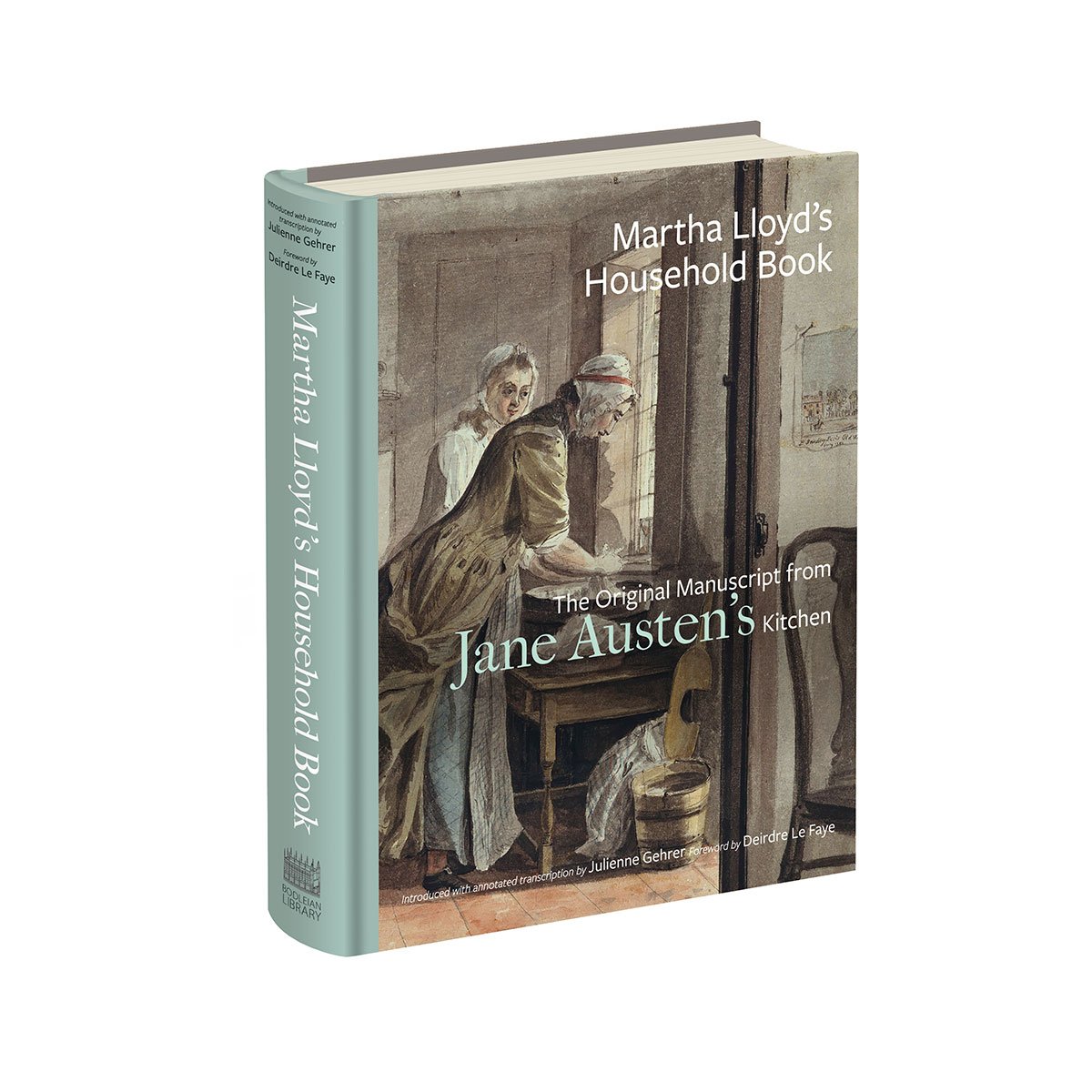Book reviewers are not supposed to reveal their thoughts until the end of their review. I am breaking that rule: I LOVED this book.

Book Cover from Bodleian Shop
The book begins with Deirdre Le Faye’s excellent foreword, which, among many other good points, mentions how contemporary readers who belonged to the same gentry class as the Austens readily associated the family’s culinary choices to their own food preferences.
Martha’s book…was compiled for a family of the Middling Sort, as the expression was—unpretentious households of the literate and professional classes, not landed gentry and not necessarily well off.” – (p viii, Household Book)
Martha Lloyd in her own light
Julienne Gehrer’s comprehensive discussion of Martha Lloyd’s friendship with Jane Austen, her relationship with the Austen family, and her late-life marriage to Sir Francis Austen, Jane’s brother, had me mesmerized. Previously, I only had a general knowledge of Martha’s friendship with Jane, but this book placed their relationship into a clear and loving perspective. Four years after George Austen’s death in 1805 in Bath, the Austen women, with Martha in tow, moved from one rented house to another, until they settled in Chawton Cottage in 1809 on Edward Austen’s Hampshire estate. There, Martha was given a large bedroom. This must have been quite an honor!
Martha’s relationship with the Austens did not end with Jane’s death in 1817, but lasted throughout her life. Her marriage at 62 years of age finally made her an Austen in name as well as in spirit. While Gehrer describes the sisterly affection between Jane Austen and Martha Lloyd in a concise 30 pages, there is so much more to this book that is represented in that short account of their friendship.
Historical context of Martha’s household book
In this section, Gehrer places Martha’s book in historical context.
… a lady’s household book was an essential tool for managing her home.” (p. 31)
These household books were written by the reigning ladies of the house to communicate with their cook and housekeeper. Early on they were private, not published, and described their own preferences. The books included recipes and information they inherited from their mothers, relatives, and friends. The women felt free to copy from each other and from popular cookery books, such as Hannah Glasse’s seminal book from 1775.
Lloyd’s contemporaries would not have known of The Housekeeping Book of Susanna Whatman, written in 1776-1800. It remained a private household book until it was found and published in 1952. My copy from The National Trust reveals Whatman’s knowledge of housekeeping and daily oversight of her servants via her specific instructions. She married young and one can imagine that as a new bride ruling her first household, she must have clung to her mother’s and grandmother’s advice for guidance and comfort.
Gehrer traces the evolution of these household books and their varied uses. Country or city settings influenced the information that the women included.
Household books compiled in country setting often include ‘A Cure for Mange in Horses or Dogs and the necessary for ‘the cure of the Bite of a Mad Dog’, as does Marrha’s book.” – (p. 37)
The author also gives us tips on working with period recipes, cautioning us about creative spelling during the Georgian period, common word abbreviations, and the variable quantities mentioned, such as ‘a piece of dough the size of a walnut’. Often instructions assume that the cook already knows about which preliminary steps to take or how many hours of preparation might be expected. The modern cook has no such knowledge. Gehrer also cautions:
Many original recipes, both culinary and medicinal, contain ingredients now known to be toxic and are not advised for consumption or use.” – (p. 41)
Nevertheless, many interesting historic recipes remain that can be safely followed, through which this book guides the reader.
Unique details and connections to Jane Austen in Martha’s book
Gehrer then examines why Lloyd’s household book is of such historical importance. Rosa Mary Mowll, a great-granddaughter of Francis Austen and granddaughter of his child, Edward Thomas Austen, wrote a letter to a trustee of the Jane Austen Society about the book, but failed to mention the direct Austen contributions. Her offer was not deemed important and thus this primary source wasn’t initially accepted by the Austen experts from the Society. Thankfully, her insistence and persistence influenced better minds to prevail and helped the book find its rightful place in history.
In June 1956, Martha Lloyd’s Household Book became part of the collection at Jane Austen’s House…” – (p. 44)
A full description of the book, including missing pages, descriptions of Martha’s script (with photographic images), dates of contributions and the names of contributors are included. The book then makes direct connections to Jane Austen and the recipes in her novels, and her family’s favourite dishes and recipes. Fancy French fare and dinners for the middling sort are described.
…examples of simple and abundant country foods permeate Jane’s writing and Martha’s household book. It is easy to envision Mrs Austen’s Steventon dairy producing pails of milk, pints of cream and pounds of butter, inspiring young Jane’s food-laden ‘Lesley Castle.’” – (p. 60)
Particulars of Martha Lloyd’s household book
This section, which starts on page 67, is the piece de resistance of this book – the first facsimile publication, in color, of this notebook ever. It is followed by a complete transcription of Georgian era cursive writing, and includes detailed annotations that help the modern reader interpret the recipes in ways we can understand. A glossary, extensive notes, and bibliography are included, as well as beautifully reproduced images.
Contrast this book to The Knight Family Cookbook from the Chawton House Press, 2014. I bought this book at the AGM in Williamsburg in 2019 in support of this important institution and do not regret its purchase, but I would love to see a reissue. The preface by Richard Knight and Introduction by Gillian Dow were a scant 7 pages, followed by a grey and black facsimile of the cookbook without a transcription of the cursive writing, which at times was hard to read or follow, making it hard to interpret the recipes. Again, my purchase went to a good cause, but for practical purposes, I could not make heads or tails of a majority of the recipes.
In conclusion
For those who are intrigued with the story of Martha Lloyd and Jane Austen, a wonderful current companion piece is the recently published Jane Austen’s Best Friend by Zöe Wheddon, which adds so much color and flavor to Martha Lloyd’s Household Book: The Original Manuscript from Jane Austen’s Kitchen.
About the author
Julienne Gehrer is an author, journalist and food historian who lectures on Jane Austen and the long eighteenth century. Her articles have appeared in Texas Studies for Literature and Language, Jane Austen’s Regency World, and JASNA News. She is the author of several books including this one and Dining with Jane Austen (2017).
More about Martha Lloyd
- Read Rachel Dodge’s Book Review: Jane Austen’s Best Friend and her interview with the author here. Both are on this blog.
- Martha Lloyd: Jane Austen’s “Second Sister”, Laura Boyle
Purchase the book
Gehrer, J. (2021) Martha Lloyd’s Household Book: The Original Manuscript from Jane Austen’s Kitchen (1st ed., U.K.) Bodleian Library.
UK: Bodleian Shop – Click here to order the book
US: publication August, 2021 – Click here to order the book on Amazon








